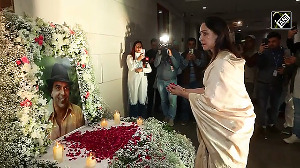
Racing against time, rescuers on Sunday waded through tonnes of rubble of flattened homes and buildings in Nepal to look for survivors of the earthquake that has killed over 2,350 people, including five Indians, and left more than 6,000 others injured.
Fresh powerful aftershocks today triggered panic among the stricken people and caused avalanches on Mt Everest which had on Saturday taken a toll of 22 lives.
A strong 6.7-magnitude aftershock followed by another measuring 6.5 on the Richter Scale, sent people scrambling for open spaces.
The 7.9-magnitude temblor yesterday left a trail of devastation and suffering, with people spending the cold night in the open because of fears of fresh quake.
According to the latest figures available with the Kathmandu-based National Emergency Operation Centre, the death toll in Nepal stood at 2,352 and 6,239 had been injured.
1,053 people are reported killed in the Kathmandu Valley alone. Officials fear the death toll could rise as desperate search for survivors continued.
International rescue teams, including from India, have touched down here as Nepal declared a state of emergency in the wake of the disaster, the worst in over 80 years of the country's recorded history.
India has mounted a major rescue and rehabilitation effort, deploying 13 military aircraft which carried medicines, field hospitals, blankets, 50 tonnes of water and other materials.
More than 700 disaster relief experts drawn from the National Disaster Relief Force have been deployed by India.
A senior-level inter-ministerial team will visit Nepal to assess how India can better assist in the relief operations.
Rescuers have been hunting for survivors under heaps of debris with bare hands as well as heavy equipment though the efforts have been hampered due to fresh tremors, thunderstorms and snowfall in the mountain ranges.

Locals and tourists sifted through mounds of debris for survivors. Cheers rose when people were found alive, though mostly bodies were pulled out.
MI-17 helicopters of the Indian Air Force have carried out five casualty evacuation sorties and the injured have been moved to military hospitals.
An Indian attempting to climb all the highest peaks in the seven continents, 54-year-old Ankur Bahl is also stuck at Camp II on Mount Everest along with 11 other fellow climbers.
Bahl had moved to Camp II from Camp I yesterday but is now stranded due to the earthquake.
The earthquake and the aftershocks left behind a trail of death and destruction, flattening houses and buildings, including the iconic Dharhara tower and the landmark Darbar Square in the heart of the capital, trapping scores of people.
According to initial reports related to Sunday’s aftershock, a tunnel caved in at the Trishuli Hydel Project and around 60 labourers are feared trapped.
Hospitals in Nepal are struggling to accommodate the number of injured that is running into thousands. People have been lying scattered on the floor and even on the ground outside and receiving treatment.
The Nepalese government has established a fund of Rs 500 million for the reconstruction of the damaged infrastructure.
With electric poles and lines uprooted, most parts of the country have no electricity since Saturday afternoon and authorities say the situation is likely to continue for the next few days.
26 districts are the most affected in Nepal though the far western part of the country has been declared safe.
Offers of help poured in from around the world following the Nepalese government's appeal for assistance, with the US, the European Union as well the United States saying they were sending in disaster response teams.
Nepal has requested international assistance in the response to the disaster, with particular importance placed on the search and rescue capacity, medical teams, supplies and tenting for hospitals, heavy equipment for rubble removal and helicopters for transport and access to blocked areas.
A large number of Indians, including many workers who visit the neighbouring country, said they were faced with basic problems like food and sanitation.
Officials here said five Indians, including the daughter of an Indian embassy employee, were among those killed in the quake.
Like many other areas of Nepal, Kathmandu is facing a colossal challenge of dealing with the devastation from the disaster.

Whole streets and squares were covered in rubble in the capital, with an estimated metropolitan area population of around 3 million residents.
As military helicopters hovered over Kathmandu and ferried relief supplies to victims of the earthquake in western Nepal, search and rescue efforts were going on in at least five locations in Kathmandu.
Near Prime Minister Sushil Koirala's official residence, two bulldozers scoured the rubble of a flattened four-storey house. A bystander said it was the local tax office. The bodies of the four staff inside had been recovered minutes before.
The United States, Britain, China, Pakistan and European Union countries are among those who have pledged aid.
A number of international charities including Red Cross, Oxfam, Doctors Without Borders and Christian Aid are also sending teams to quake-hit areas.
The International Federation of the Red Cross and Red Crescent Societies said it was especially worried about the fate of villages near the epicentre of the quake, some 80 km from Kathmandu.
The problems have been compounded by erratic internet and mobile phone communications.
Beyond colossal loss of human lives, if there is anything perhaps equally overwhelming in Nepal's earthquake tragedy, it is the monumental damage the country's iconic heritage has suffered due to the calamity.
The powerful temblor practically levelled the nation's tangible cultural history, robbing it of its architectural jewels, including the landmark Dharhara Tower, in an eerie reminder of the 1934 quake that claimed over 10,000 lives.
The Kathmandu Valley inscribed in the World Heritage list in 1979 include the Durbar Squares of Hanuman Dhoka (Kathmandu), Patan and Bhaktapur, the Buddhist stupas of Swayambhu and Bauddhanath and the Hindu temples of Pashupati and Changu Narayan.
Tragedy came to revisit all the three Squares, as the sites had suffered extensive damage in the 1934 disaster too.
Nepal is likely to experience widespread rains and thundershowers which may trigger landslides, according to India's weather department which has asked people to remain alert.










